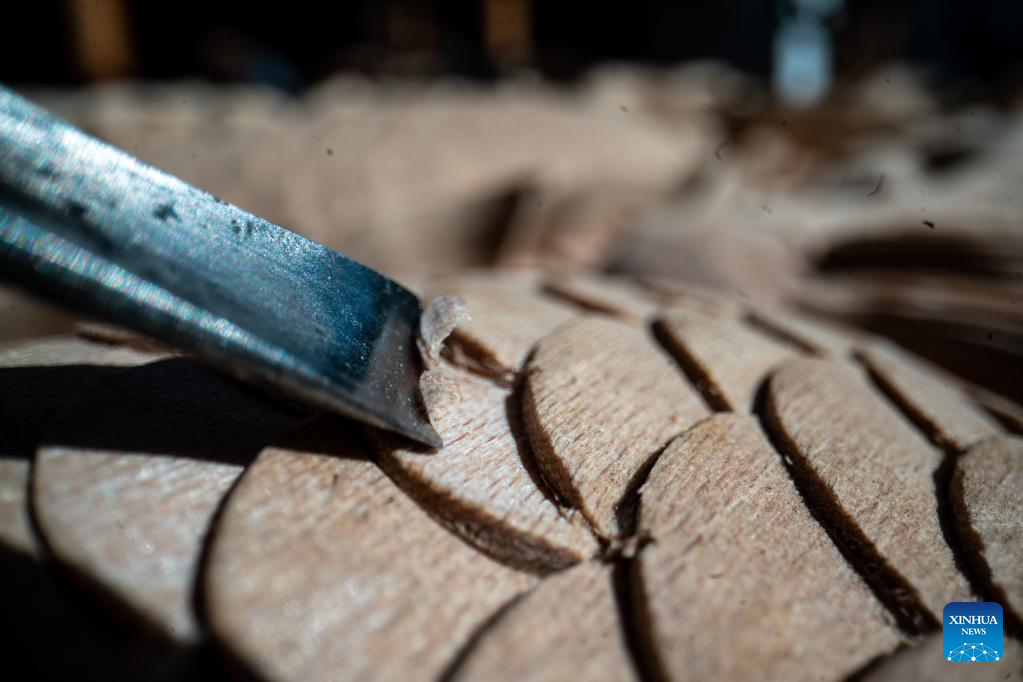
Duan Sixing sleeks a woodcarving work in Jianchuan County, Dali Bai Autonomous Prefecture of southwest China's Yunnan Province, Dec. 1, 2022. Jianchuan County, located in Dali Bai Autonomous Prefecture of southwest China's Yunnan Province, has a long history in woodcarving dating back to the Tang (618-907) and Song (960-1279) dynasties. The carving skills gradually developed from one-layer relief to even seven-layer hollowing relief, and are now applied to making architecture parts, wooden furniture, wall paintings and tourism souvenirs. A high-standard "Four Screens", a representative displaying form of the craft, requires high-level carving skills and costs several months to create. In 2011, Jianchuan woodcarving was listed as one of China's national-level intangible cultural heritages.
Duan Sixing, born in a woodcarving family in Jianchuan County, was deeply edified since childhood by his father and grandfather who were all excellent carpenters. After graduating from middle school, Duan was enrolled into a vocational school to learn woodcarving systematically. "For a new hand, to get in touch with the core skills needs at least three years of sound study, " Duan said. In 2011, Duan took his woodcarving work to participate in an exhibition of Chinese woodcarving at the National Museum of China. In 2014, he brought his Jianchuan woodcarving work to take part in a promotion event of Yunnan Province at the Palace of Nations in Geneva of Switzerland.
Duan was acknowledged as the national-level intangible cultural heritage inheritor of Jianchuan woodcarving in 2018. In an aim to promote the art, he has set up a Jianchuan woodcarving institute at his hometown, and also cooperated with art colleges, encouraging his apprentices to make new creations on the basis of the tradition. "We plan to integrate woodcarving into people's daily life by making creative artworks, so that more people can appreciate Jianchuan woodcarving craft, " said Duan, who is confident in the future of the craft. So far, there are more than 20,000 people engaged in the profession in Jianchuan. (Xinhua/Jiang Wenyao)
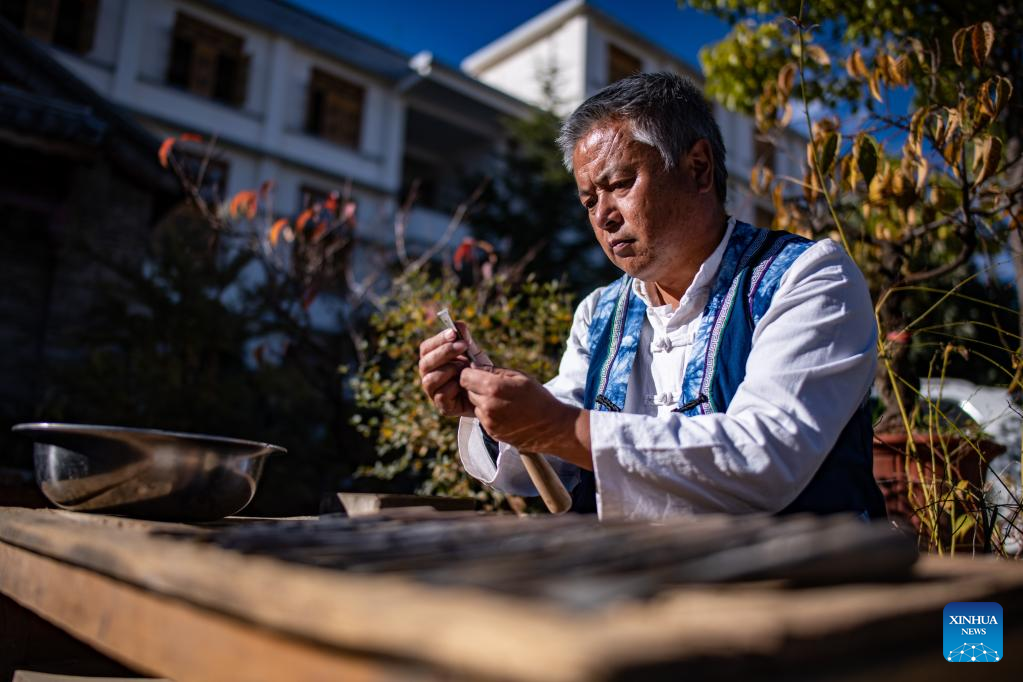
Duan Sixing polishes tools for woodcarving in Jianchuan County, Dali Bai Autonomous Prefecture of southwest China's Yunnan Province, Dec. 1, 2022. Jianchuan County, located in Dali Bai Autonomous Prefecture of southwest China's Yunnan Province, has a long history in woodcarving dating back to the Tang (618-907) and Song (960-1279) dynasties. The carving skills gradually developed from one-layer relief to even seven-layer hollowing relief, and are now applied to making architecture parts, wooden furniture, wall paintings and tourism souvenirs. A high-standard "Four Screens", a representative displaying form of the craft, requires high-level carving skills and costs several months to create. In 2011, Jianchuan woodcarving was listed as one of China's national-level intangible cultural heritages.
Duan Sixing, born in a woodcarving family in Jianchuan County, was deeply edified since childhood by his father and grandfather who were all excellent carpenters. After graduating from middle school, Duan was enrolled into a vocational school to learn woodcarving systematically. "For a new hand, to get in touch with the core skills needs at least three years of sound study, " Duan said. In 2011, Duan took his woodcarving work to participate in an exhibition of Chinese woodcarving at the National Museum of China. In 2014, he brought his Jianchuan woodcarving work to take part in a promotion event of Yunnan Province at the Palace of Nations in Geneva of Switzerland.
Duan was acknowledged as the national-level intangible cultural heritage inheritor of Jianchuan woodcarving in 2018. In an aim to promote the art, he has set up a Jianchuan woodcarving institute at his hometown, and also cooperated with art colleges, encouraging his apprentices to make new creations on the basis of the tradition. "We plan to integrate woodcarving into people's daily life by making creative artworks, so that more people can appreciate Jianchuan woodcarving craft, " said Duan, who is confident in the future of the craft. So far, there are more than 20,000 people engaged in the profession in Jianchuan. (Xinhua/Jiang Wenyao)
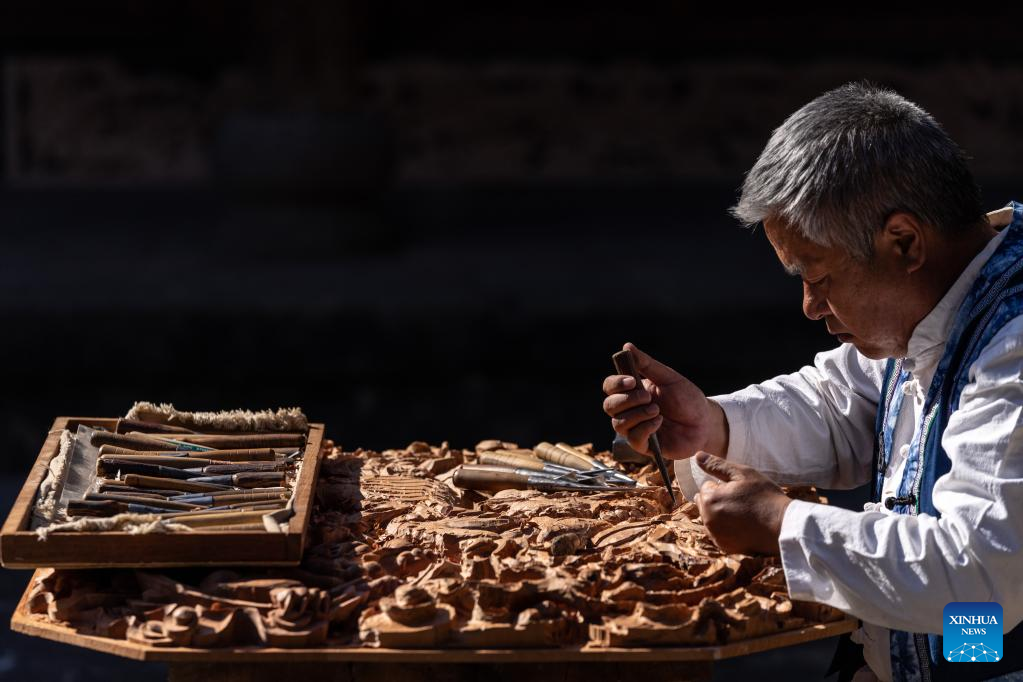
Duan Sixing makes a woodcarving work in Jianchuan County, Dali Bai Autonomous Prefecture of southwest China's Yunnan Province, Dec. 1, 2022. Jianchuan County, located in Dali Bai Autonomous Prefecture of southwest China's Yunnan Province, has a long history in woodcarving dating back to the Tang (618-907) and Song (960-1279) dynasties. The carving skills gradually developed from one-layer relief to even seven-layer hollowing relief, and are now applied to making architecture parts, wooden furniture, wall paintings and tourism souvenirs. A high-standard "Four Screens", a representative displaying form of the craft, requires high-level carving skills and costs several months to create. In 2011, Jianchuan woodcarving was listed as one of China's national-level intangible cultural heritages.
Duan Sixing, born in a woodcarving family in Jianchuan County, was deeply edified since childhood by his father and grandfather who were all excellent carpenters. After graduating from middle school, Duan was enrolled into a vocational school to learn woodcarving systematically. "For a new hand, to get in touch with the core skills needs at least three years of sound study, " Duan said. In 2011, Duan took his woodcarving work to participate in an exhibition of Chinese woodcarving at the National Museum of China. In 2014, he brought his Jianchuan woodcarving work to take part in a promotion event of Yunnan Province at the Palace of Nations in Geneva of Switzerland.
Duan was acknowledged as the national-level intangible cultural heritage inheritor of Jianchuan woodcarving in 2018. In an aim to promote the art, he has set up a Jianchuan woodcarving institute at his hometown, and also cooperated with art colleges, encouraging his apprentices to make new creations on the basis of the tradition. "We plan to integrate woodcarving into people's daily life by making creative artworks, so that more people can appreciate Jianchuan woodcarving craft, " said Duan, who is confident in the future of the craft. So far, there are more than 20,000 people engaged in the profession in Jianchuan. (Xinhua/Hu Chao)
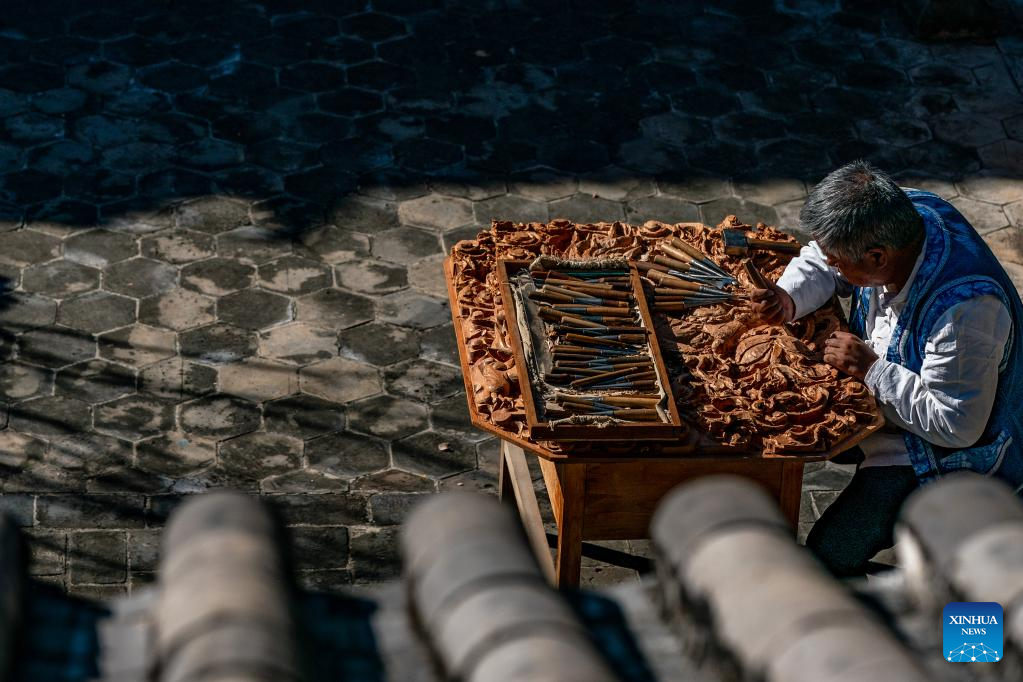
Duan Sixing makes a woodcarving work in Jianchuan County, Dali Bai Autonomous Prefecture of southwest China's Yunnan Province, Dec. 1, 2022. Jianchuan County, located in Dali Bai Autonomous Prefecture of southwest China's Yunnan Province, has a long history in woodcarving dating back to the Tang (618-907) and Song (960-1279) dynasties. The carving skills gradually developed from one-layer relief to even seven-layer hollowing relief, and are now applied to making architecture parts, wooden furniture, wall paintings and tourism souvenirs. A high-standard "Four Screens", a representative displaying form of the craft, requires high-level carving skills and costs several months to create. In 2011, Jianchuan woodcarving was listed as one of China's national-level intangible cultural heritages.
Duan Sixing, born in a woodcarving family in Jianchuan County, was deeply edified since childhood by his father and grandfather who were all excellent carpenters. After graduating from middle school, Duan was enrolled into a vocational school to learn woodcarving systematically. "For a new hand, to get in touch with the core skills needs at least three years of sound study, " Duan said. In 2011, Duan took his woodcarving work to participate in an exhibition of Chinese woodcarving at the National Museum of China. In 2014, he brought his Jianchuan woodcarving work to take part in a promotion event of Yunnan Province at the Palace of Nations in Geneva of Switzerland.
Duan was acknowledged as the national-level intangible cultural heritage inheritor of Jianchuan woodcarving in 2018. In an aim to promote the art, he has set up a Jianchuan woodcarving institute at his hometown, and also cooperated with art colleges, encouraging his apprentices to make new creations on the basis of the tradition. "We plan to integrate woodcarving into people's daily life by making creative artworks, so that more people can appreciate Jianchuan woodcarving craft, " said Duan, who is confident in the future of the craft. So far, there are more than 20,000 people engaged in the profession in Jianchuan. (Xinhua/Hu Chao)
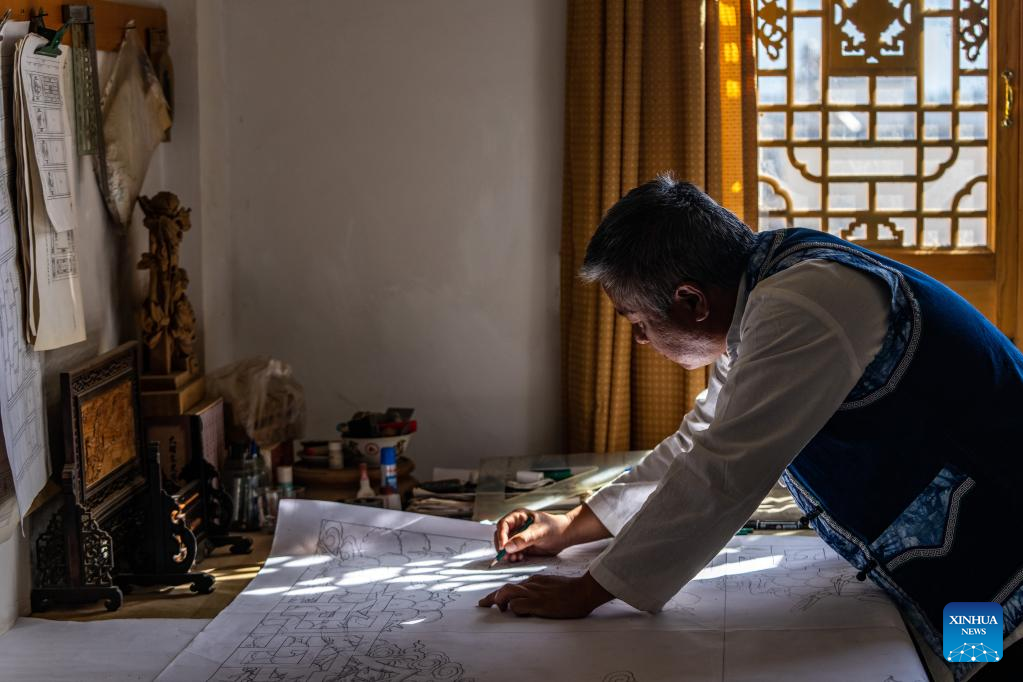
Duan Sixing draws woodcarving patterns at his studio in Jianchuan County, Dali Bai Autonomous Prefecture of southwest China's Yunnan Province, Dec. 2, 2022. Jianchuan County, located in Dali Bai Autonomous Prefecture of southwest China's Yunnan Province, has a long history in woodcarving dating back to the Tang (618-907) and Song (960-1279) dynasties. The carving skills gradually developed from one-layer relief to even seven-layer hollowing relief, and are now applied to making architecture parts, wooden furniture, wall paintings and tourism souvenirs. A high-standard "Four Screens", a representative displaying form of the craft, requires high-level carving skills and costs several months to create. In 2011, Jianchuan woodcarving was listed as one of China's national-level intangible cultural heritages.
Duan Sixing, born in a woodcarving family in Jianchuan County, was deeply edified since childhood by his father and grandfather who were all excellent carpenters. After graduating from middle school, Duan was enrolled into a vocational school to learn woodcarving systematically. "For a new hand, to get in touch with the core skills needs at least three years of sound study, " Duan said. In 2011, Duan took his woodcarving work to participate in an exhibition of Chinese woodcarving at the National Museum of China. In 2014, he brought his Jianchuan woodcarving work to take part in a promotion event of Yunnan Province at the Palace of Nations in Geneva of Switzerland.
Duan was acknowledged as the national-level intangible cultural heritage inheritor of Jianchuan woodcarving in 2018. In an aim to promote the art, he has set up a Jianchuan woodcarving institute at his hometown, and also cooperated with art colleges, encouraging his apprentices to make new creations on the basis of the tradition. "We plan to integrate woodcarving into people's daily life by making creative artworks, so that more people can appreciate Jianchuan woodcarving craft, " said Duan, who is confident in the future of the craft. So far, there are more than 20,000 people engaged in the profession in Jianchuan. (Xinhua/Hu Chao)
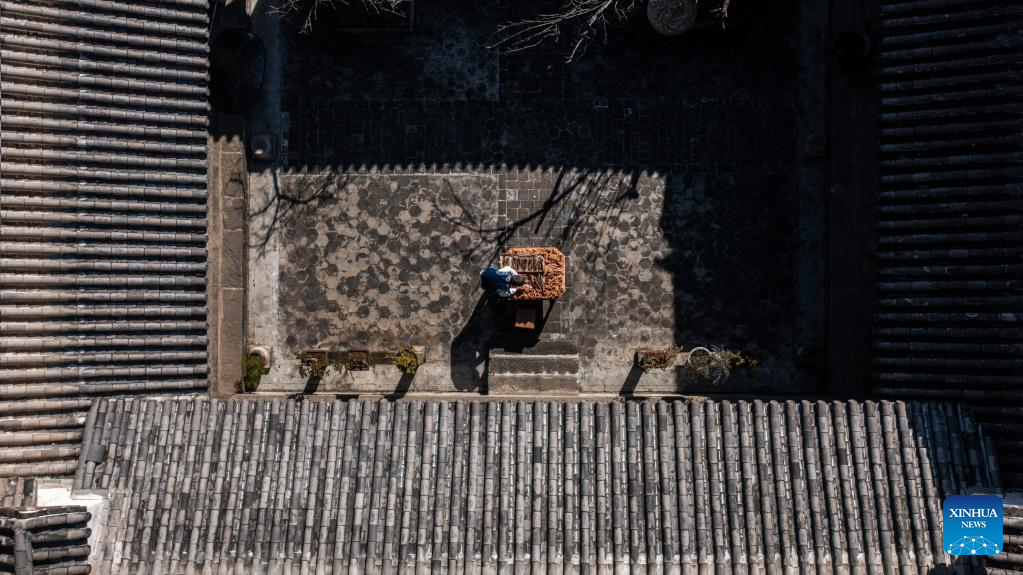
This aerial photo shows Duan Sixing making a woodcarving work in Jianchuan County, Dali Bai Autonomous Prefecture of southwest China's Yunnan Province, Dec. 1, 2022. Jianchuan County, located in Dali Bai Autonomous Prefecture of southwest China's Yunnan Province, has a long history in woodcarving dating back to the Tang (618-907) and Song (960-1279) dynasties. The carving skills gradually developed from one-layer relief to even seven-layer hollowing relief, and are now applied to making architecture parts, wooden furniture, wall paintings and tourism souvenirs. A high-standard "Four Screens", a representative displaying form of the craft, requires high-level carving skills and costs several months to create. In 2011, Jianchuan woodcarving was listed as one of China's national-level intangible cultural heritages.
Duan Sixing, born in a woodcarving family in Jianchuan County, was deeply edified since childhood by his father and grandfather who were all excellent carpenters. After graduating from middle school, Duan was enrolled into a vocational school to learn woodcarving systematically. "For a new hand, to get in touch with the core skills needs at least three years of sound study, " Duan said. In 2011, Duan took his woodcarving work to participate in an exhibition of Chinese woodcarving at the National Museum of China. In 2014, he brought his Jianchuan woodcarving work to take part in a promotion event of Yunnan Province at the Palace of Nations in Geneva of Switzerland.
Duan was acknowledged as the national-level intangible cultural heritage inheritor of Jianchuan woodcarving in 2018. In an aim to promote the art, he has set up a Jianchuan woodcarving institute at his hometown, and also cooperated with art colleges, encouraging his apprentices to make new creations on the basis of the tradition. "We plan to integrate woodcarving into people's daily life by making creative artworks, so that more people can appreciate Jianchuan woodcarving craft, " said Duan, who is confident in the future of the craft. So far, there are more than 20,000 people engaged in the profession in Jianchuan. (Xinhua/Hu Chao)

Duan Sixing makes a woodcarving work in Jianchuan County, Dali Bai Autonomous Prefecture of southwest China's Yunnan Province, Dec. 1, 2022. Jianchuan County, located in Dali Bai Autonomous Prefecture of southwest China's Yunnan Province, has a long history in woodcarving dating back to the Tang (618-907) and Song (960-1279) dynasties. The carving skills gradually developed from one-layer relief to even seven-layer hollowing relief, and are now applied to making architecture parts, wooden furniture, wall paintings and tourism souvenirs. A high-standard "Four Screens", a representative displaying form of the craft, requires high-level carving skills and costs several months to create. In 2011, Jianchuan woodcarving was listed as one of China's national-level intangible cultural heritages.
Duan Sixing, born in a woodcarving family in Jianchuan County, was deeply edified since childhood by his father and grandfather who were all excellent carpenters. After graduating from middle school, Duan was enrolled into a vocational school to learn woodcarving systematically. "For a new hand, to get in touch with the core skills needs at least three years of sound study, " Duan said. In 2011, Duan took his woodcarving work to participate in an exhibition of Chinese woodcarving at the National Museum of China. In 2014, he brought his Jianchuan woodcarving work to take part in a promotion event of Yunnan Province at the Palace of Nations in Geneva of Switzerland.
Duan was acknowledged as the national-level intangible cultural heritage inheritor of Jianchuan woodcarving in 2018. In an aim to promote the art, he has set up a Jianchuan woodcarving institute at his hometown, and also cooperated with art colleges, encouraging his apprentices to make new creations on the basis of the tradition. "We plan to integrate woodcarving into people's daily life by making creative artworks, so that more people can appreciate Jianchuan woodcarving craft, " said Duan, who is confident in the future of the craft. So far, there are more than 20,000 people engaged in the profession in Jianchuan. (Xinhua/Hu Chao)
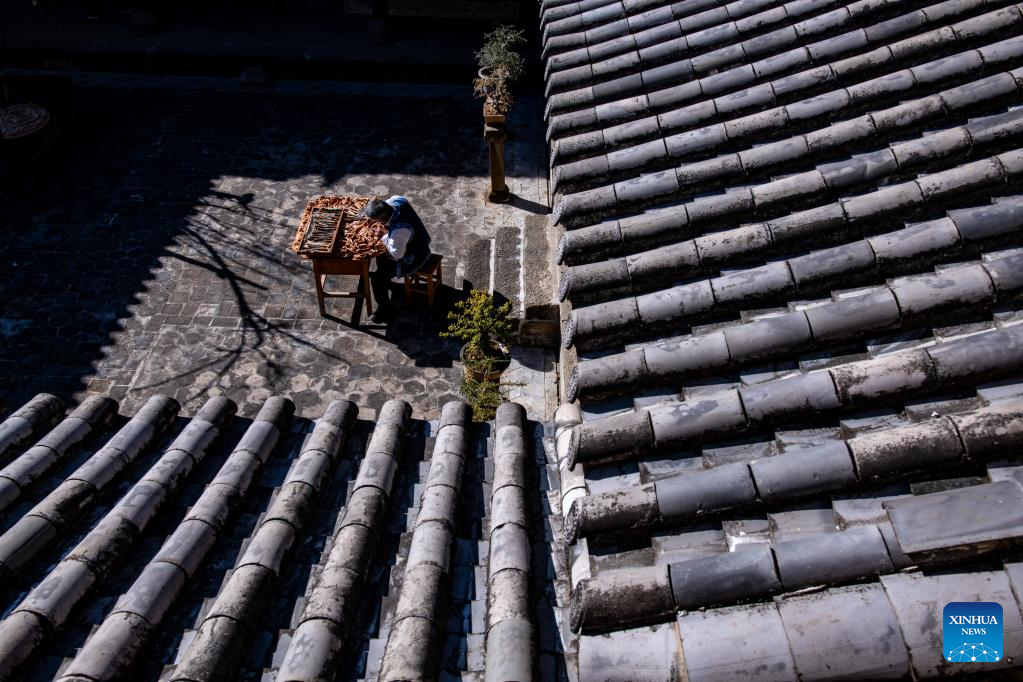
Duan Sixing makes a woodcarving work in Jianchuan County, Dali Bai Autonomous Prefecture of southwest China's Yunnan Province, Dec. 1, 2022. Jianchuan County, located in Dali Bai Autonomous Prefecture of southwest China's Yunnan Province, has a long history in woodcarving dating back to the Tang (618-907) and Song (960-1279) dynasties. The carving skills gradually developed from one-layer relief to even seven-layer hollowing relief, and are now applied to making architecture parts, wooden furniture, wall paintings and tourism souvenirs. A high-standard "Four Screens", a representative displaying form of the craft, requires high-level carving skills and costs several months to create. In 2011, Jianchuan woodcarving was listed as one of China's national-level intangible cultural heritages.
Duan Sixing, born in a woodcarving family in Jianchuan County, was deeply edified since childhood by his father and grandfather who were all excellent carpenters. After graduating from middle school, Duan was enrolled into a vocational school to learn woodcarving systematically. "For a new hand, to get in touch with the core skills needs at least three years of sound study, " Duan said. In 2011, Duan took his woodcarving work to participate in an exhibition of Chinese woodcarving at the National Museum of China. In 2014, he brought his Jianchuan woodcarving work to take part in a promotion event of Yunnan Province at the Palace of Nations in Geneva of Switzerland.
Duan was acknowledged as the national-level intangible cultural heritage inheritor of Jianchuan woodcarving in 2018. In an aim to promote the art, he has set up a Jianchuan woodcarving institute at his hometown, and also cooperated with art colleges, encouraging his apprentices to make new creations on the basis of the tradition. "We plan to integrate woodcarving into people's daily life by making creative artworks, so that more people can appreciate Jianchuan woodcarving craft, " said Duan, who is confident in the future of the craft. So far, there are more than 20,000 people engaged in the profession in Jianchuan. (Xinhua/Jiang Wenyao)

Duan Sixing selects wood in Jianchuan County, Dali Bai Autonomous Prefecture of southwest China's Yunnan Province, Dec. 1, 2022. Jianchuan County, located in Dali Bai Autonomous Prefecture of southwest China's Yunnan Province, has a long history in woodcarving dating back to the Tang (618-907) and Song (960-1279) dynasties. The carving skills gradually developed from one-layer relief to even seven-layer hollowing relief, and are now applied to making architecture parts, wooden furniture, wall paintings and tourism souvenirs. A high-standard "Four Screens", a representative displaying form of the craft, requires high-level carving skills and costs several months to create. In 2011, Jianchuan woodcarving was listed as one of China's national-level intangible cultural heritages.
Duan Sixing, born in a woodcarving family in Jianchuan County, was deeply edified since childhood by his father and grandfather who were all excellent carpenters. After graduating from middle school, Duan was enrolled into a vocational school to learn woodcarving systematically. "For a new hand, to get in touch with the core skills needs at least three years of sound study, " Duan said. In 2011, Duan took his woodcarving work to participate in an exhibition of Chinese woodcarving at the National Museum of China. In 2014, he brought his Jianchuan woodcarving work to take part in a promotion event of Yunnan Province at the Palace of Nations in Geneva of Switzerland.
Duan was acknowledged as the national-level intangible cultural heritage inheritor of Jianchuan woodcarving in 2018. In an aim to promote the art, he has set up a Jianchuan woodcarving institute at his hometown, and also cooperated with art colleges, encouraging his apprentices to make new creations on the basis of the tradition. "We plan to integrate woodcarving into people's daily life by making creative artworks, so that more people can appreciate Jianchuan woodcarving craft, " said Duan, who is confident in the future of the craft. So far, there are more than 20,000 people engaged in the profession in Jianchuan. (Xinhua/Jiang Wenyao)
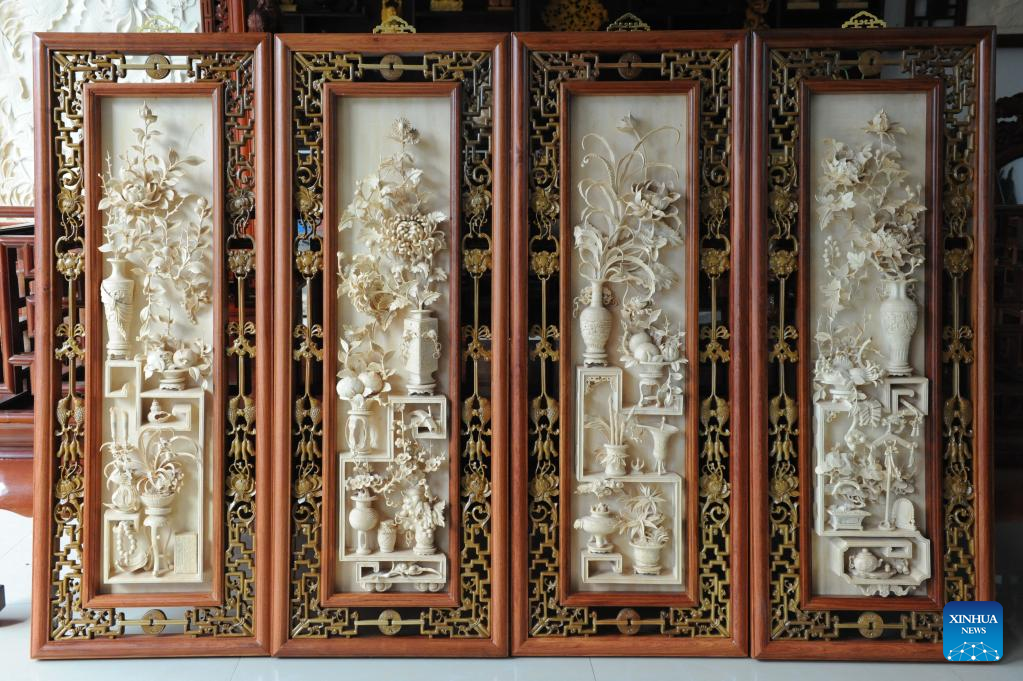
This photo taken in 2012 shows a "Four Screens" woodcarving work by Duan Sixing in Jianchuan County, Dali Bai Autonomous Prefecture of southwest China's Yunnan Province. Jianchuan County, located in Dali Bai Autonomous Prefecture of southwest China's Yunnan Province, has a long history in woodcarving dating back to the Tang (618-907) and Song (960-1279) dynasties. The carving skills gradually developed from one-layer relief to even seven-layer hollowing relief, and are now applied to making architecture parts, wooden furniture, wall paintings and tourism souvenirs. A high-standard "Four Screens", a representative displaying form of the craft, requires high-level carving skills and costs several months to create. In 2011, Jianchuan woodcarving was listed as one of China's national-level intangible cultural heritages.
Duan Sixing, born in a woodcarving family in Jianchuan County, was deeply edified since childhood by his father and grandfather who were all excellent carpenters. After graduating from middle school, Duan was enrolled into a vocational school to learn woodcarving systematically. "For a new hand, to get in touch with the core skills needs at least three years of sound study, " Duan said. In 2011, Duan took his woodcarving work to participate in an exhibition of Chinese woodcarving at the National Museum of China. In 2014, he brought his Jianchuan woodcarving work to take part in a promotion event of Yunnan Province at the Palace of Nations in Geneva of Switzerland.
Duan was acknowledged as the national-level intangible cultural heritage inheritor of Jianchuan woodcarving in 2018. In an aim to promote the art, he has set up a Jianchuan woodcarving institute at his hometown, and also cooperated with art colleges, encouraging his apprentices to make new creations on the basis of the tradition. "We plan to integrate woodcarving into people's daily life by making creative artworks, so that more people can appreciate Jianchuan woodcarving craft, " said Duan, who is confident in the future of the craft. So far, there are more than 20,000 people engaged in the profession in Jianchuan. (Xinhua)
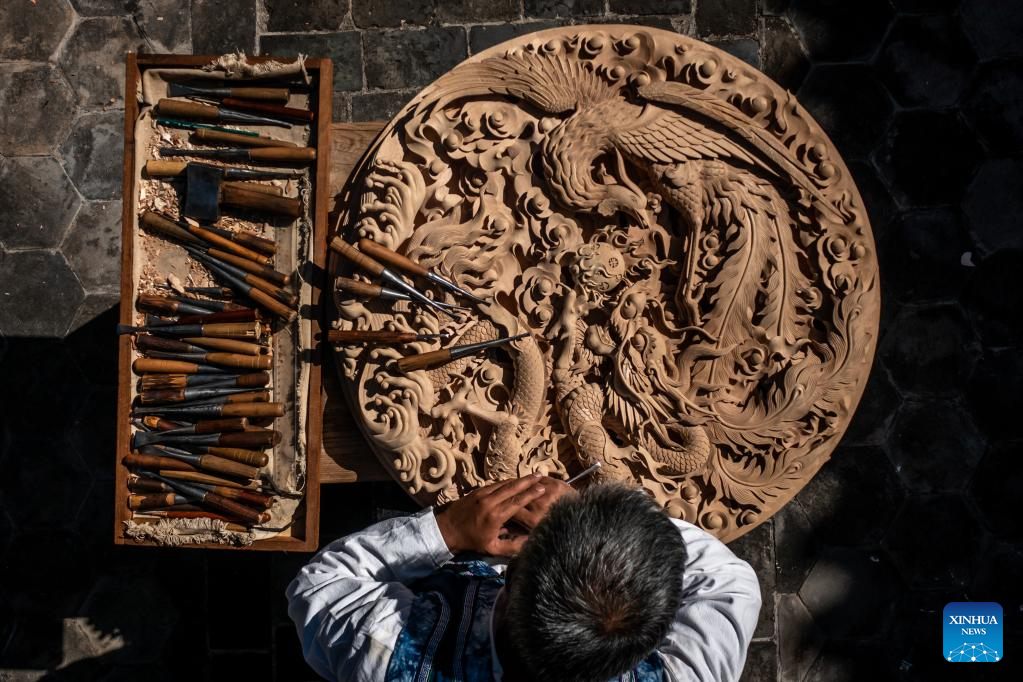
This aerial photo shows Duan Sixing sleeking a woodcarving work in Jianchuan County, Dali Bai Autonomous Prefecture of southwest China's Yunnan Province, Dec. 1, 2022. Jianchuan County, located in Dali Bai Autonomous Prefecture of southwest China's Yunnan Province, has a long history in woodcarving dating back to the Tang (618-907) and Song (960-1279) dynasties. The carving skills gradually developed from one-layer relief to even seven-layer hollowing relief, and are now applied to making architecture parts, wooden furniture, wall paintings and tourism souvenirs. A high-standard "Four Screens", a representative displaying form of the craft, requires high-level carving skills and costs several months to create. In 2011, Jianchuan woodcarving was listed as one of China's national-level intangible cultural heritages.
Duan Sixing, born in a woodcarving family in Jianchuan County, was deeply edified since childhood by his father and grandfather who were all excellent carpenters. After graduating from middle school, Duan was enrolled into a vocational school to learn woodcarving systematically. "For a new hand, to get in touch with the core skills needs at least three years of sound study, " Duan said. In 2011, Duan took his woodcarving work to participate in an exhibition of Chinese woodcarving at the National Museum of China. In 2014, he brought his Jianchuan woodcarving work to take part in a promotion event of Yunnan Province at the Palace of Nations in Geneva of Switzerland.
Duan was acknowledged as the national-level intangible cultural heritage inheritor of Jianchuan woodcarving in 2018. In an aim to promote the art, he has set up a Jianchuan woodcarving institute at his hometown, and also cooperated with art colleges, encouraging his apprentices to make new creations on the basis of the tradition. "We plan to integrate woodcarving into people's daily life by making creative artworks, so that more people can appreciate Jianchuan woodcarving craft, " said Duan, who is confident in the future of the craft. So far, there are more than 20,000 people engaged in the profession in Jianchuan. (Xinhua/Hu Chao)

Duan Sixing checks on woodcarving patterns at his studio in Jianchuan County, Dali Bai Autonomous Prefecture of southwest China's Yunnan Province, Dec. 2, 2022. Jianchuan County, located in Dali Bai Autonomous Prefecture of southwest China's Yunnan Province, has a long history in woodcarving dating back to the Tang (618-907) and Song (960-1279) dynasties. The carving skills gradually developed from one-layer relief to even seven-layer hollowing relief, and are now applied to making architecture parts, wooden furniture, wall paintings and tourism souvenirs. A high-standard "Four Screens", a representative displaying form of the craft, requires high-level carving skills and costs several months to create. In 2011, Jianchuan woodcarving was listed as one of China's national-level intangible cultural heritages.
Duan Sixing, born in a woodcarving family in Jianchuan County, was deeply edified since childhood by his father and grandfather who were all excellent carpenters. After graduating from middle school, Duan was enrolled into a vocational school to learn woodcarving systematically. "For a new hand, to get in touch with the core skills needs at least three years of sound study, " Duan said. In 2011, Duan took his woodcarving work to participate in an exhibition of Chinese woodcarving at the National Museum of China. In 2014, he brought his Jianchuan woodcarving work to take part in a promotion event of Yunnan Province at the Palace of Nations in Geneva of Switzerland.
Duan was acknowledged as the national-level intangible cultural heritage inheritor of Jianchuan woodcarving in 2018. In an aim to promote the art, he has set up a Jianchuan woodcarving institute at his hometown, and also cooperated with art colleges, encouraging his apprentices to make new creations on the basis of the tradition. "We plan to integrate woodcarving into people's daily life by making creative artworks, so that more people can appreciate Jianchuan woodcarving craft, " said Duan, who is confident in the future of the craft. So far, there are more than 20,000 people engaged in the profession in Jianchuan. (Xinhua/Hu Chao)

Duan Sixing checks at the construction site of his woodcarving museum in Jianchuan County, Dali Bai Autonomous Prefecture of southwest China's Yunnan Province, March 11, 2023. Jianchuan County, located in Dali Bai Autonomous Prefecture of southwest China's Yunnan Province, has a long history in woodcarving dating back to the Tang (618-907) and Song (960-1279) dynasties. The carving skills gradually developed from one-layer relief to even seven-layer hollowing relief, and are now applied to making architecture parts, wooden furniture, wall paintings and tourism souvenirs. A high-standard "Four Screens", a representative displaying form of the craft, requires high-level carving skills and costs several months to create. In 2011, Jianchuan woodcarving was listed as one of China's national-level intangible cultural heritages.
Duan Sixing, born in a woodcarving family in Jianchuan County, was deeply edified since childhood by his father and grandfather who were all excellent carpenters. After graduating from middle school, Duan was enrolled into a vocational school to learn woodcarving systematically. "For a new hand, to get in touch with the core skills needs at least three years of sound study, " Duan said. In 2011, Duan took his woodcarving work to participate in an exhibition of Chinese woodcarving at the National Museum of China. In 2014, he brought his Jianchuan woodcarving work to take part in a promotion event of Yunnan Province at the Palace of Nations in Geneva of Switzerland.
Duan was acknowledged as the national-level intangible cultural heritage inheritor of Jianchuan woodcarving in 2018. In an aim to promote the art, he has set up a Jianchuan woodcarving institute at his hometown, and also cooperated with art colleges, encouraging his apprentices to make new creations on the basis of the tradition. "We plan to integrate woodcarving into people's daily life by making creative artworks, so that more people can appreciate Jianchuan woodcarving craft, " said Duan, who is confident in the future of the craft. So far, there are more than 20,000 people engaged in the profession in Jianchuan. (Xinhua/Hu Chao)
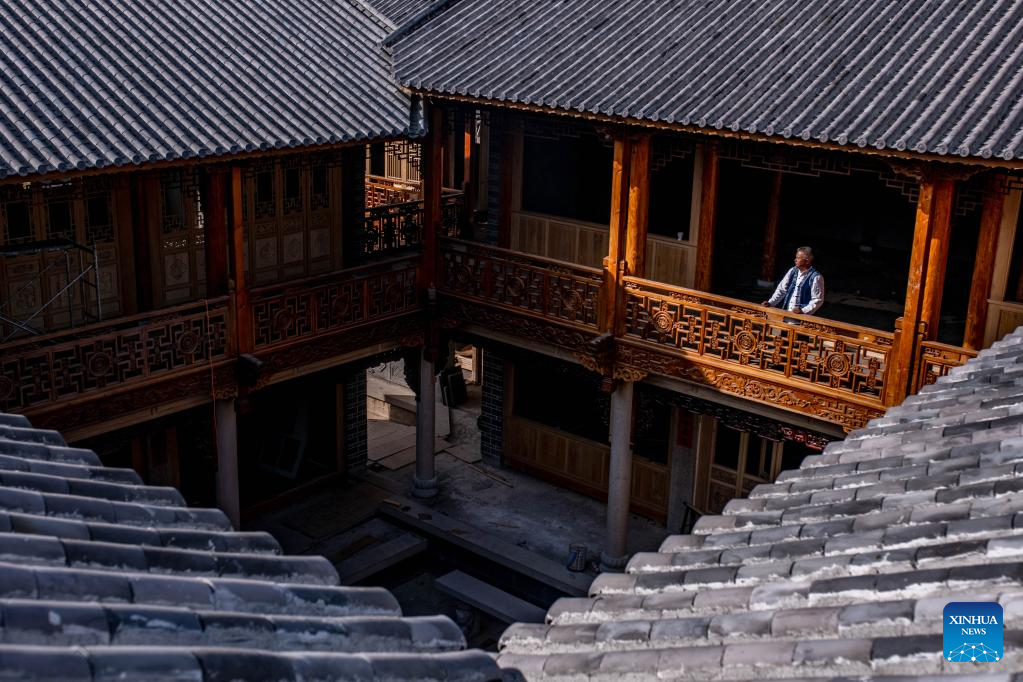
Duan Sixing checks at the construction site of his woodcarving museum in Jianchuan County, Dali Bai Autonomous Prefecture of southwest China's Yunnan Province, March 11, 2023. Jianchuan County, located in Dali Bai Autonomous Prefecture of southwest China's Yunnan Province, has a long history in woodcarving dating back to the Tang (618-907) and Song (960-1279) dynasties. The carving skills gradually developed from one-layer relief to even seven-layer hollowing relief, and are now applied to making architecture parts, wooden furniture, wall paintings and tourism souvenirs. A high-standard "Four Screens", a representative displaying form of the craft, requires high-level carving skills and costs several months to create. In 2011, Jianchuan woodcarving was listed as one of China's national-level intangible cultural heritages.
Duan Sixing, born in a woodcarving family in Jianchuan County, was deeply edified since childhood by his father and grandfather who were all excellent carpenters. After graduating from middle school, Duan was enrolled into a vocational school to learn woodcarving systematically. "For a new hand, to get in touch with the core skills needs at least three years of sound study, " Duan said. In 2011, Duan took his woodcarving work to participate in an exhibition of Chinese woodcarving at the National Museum of China. In 2014, he brought his Jianchuan woodcarving work to take part in a promotion event of Yunnan Province at the Palace of Nations in Geneva of Switzerland.
Duan was acknowledged as the national-level intangible cultural heritage inheritor of Jianchuan woodcarving in 2018. In an aim to promote the art, he has set up a Jianchuan woodcarving institute at his hometown, and also cooperated with art colleges, encouraging his apprentices to make new creations on the basis of the tradition. "We plan to integrate woodcarving into people's daily life by making creative artworks, so that more people can appreciate Jianchuan woodcarving craft, " said Duan, who is confident in the future of the craft. So far, there are more than 20,000 people engaged in the profession in Jianchuan. (Xinhua/Hu Chao)
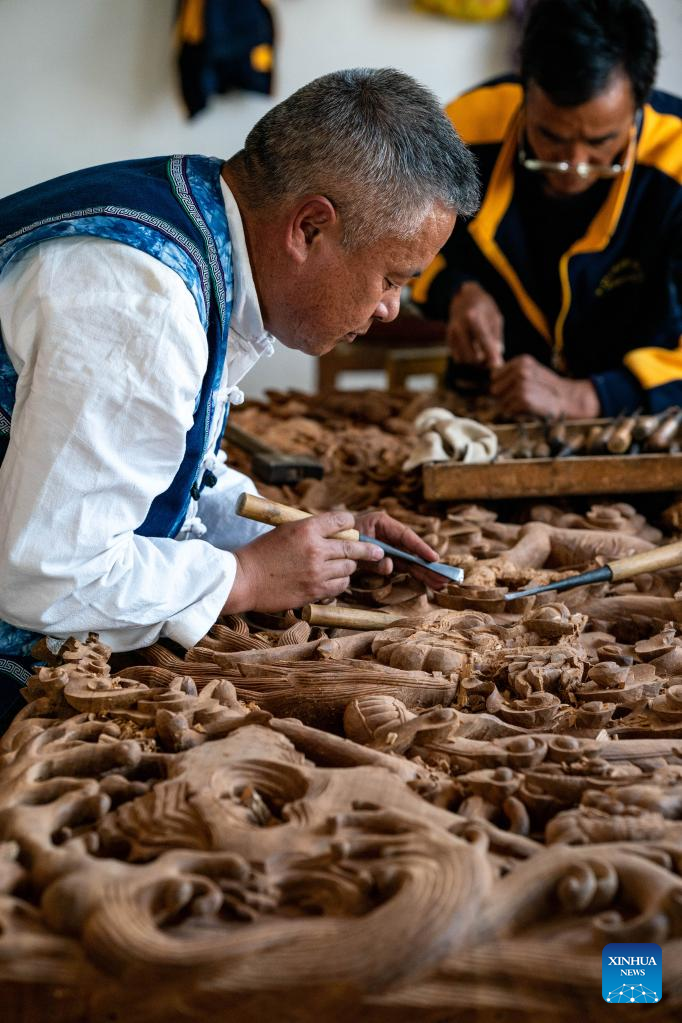
Duan Sixing (L) makes a woodcarving work at his studio in Jianchuan County, Dali Bai Autonomous Prefecture of southwest China's Yunnan Province, March 11, 2023. Jianchuan County, located in Dali Bai Autonomous Prefecture of southwest China's Yunnan Province, has a long history in woodcarving dating back to the Tang (618-907) and Song (960-1279) dynasties. The carving skills gradually developed from one-layer relief to even seven-layer hollowing relief, and are now applied to making architecture parts, wooden furniture, wall paintings and tourism souvenirs. A high-standard "Four Screens", a representative displaying form of the craft, requires high-level carving skills and costs several months to create. In 2011, Jianchuan woodcarving was listed as one of China's national-level intangible cultural heritages.
Duan Sixing, born in a woodcarving family in Jianchuan County, was deeply edified since childhood by his father and grandfather who were all excellent carpenters. After graduating from middle school, Duan was enrolled into a vocational school to learn woodcarving systematically. "For a new hand, to get in touch with the core skills needs at least three years of sound study, " Duan said. In 2011, Duan took his woodcarving work to participate in an exhibition of Chinese woodcarving at the National Museum of China. In 2014, he brought his Jianchuan woodcarving work to take part in a promotion event of Yunnan Province at the Palace of Nations in Geneva of Switzerland.
Duan was acknowledged as the national-level intangible cultural heritage inheritor of Jianchuan woodcarving in 2018. In an aim to promote the art, he has set up a Jianchuan woodcarving institute at his hometown, and also cooperated with art colleges, encouraging his apprentices to make new creations on the basis of the tradition. "We plan to integrate woodcarving into people's daily life by making creative artworks, so that more people can appreciate Jianchuan woodcarving craft, " said Duan, who is confident in the future of the craft. So far, there are more than 20,000 people engaged in the profession in Jianchuan. (Xinhua/Hu Chao)
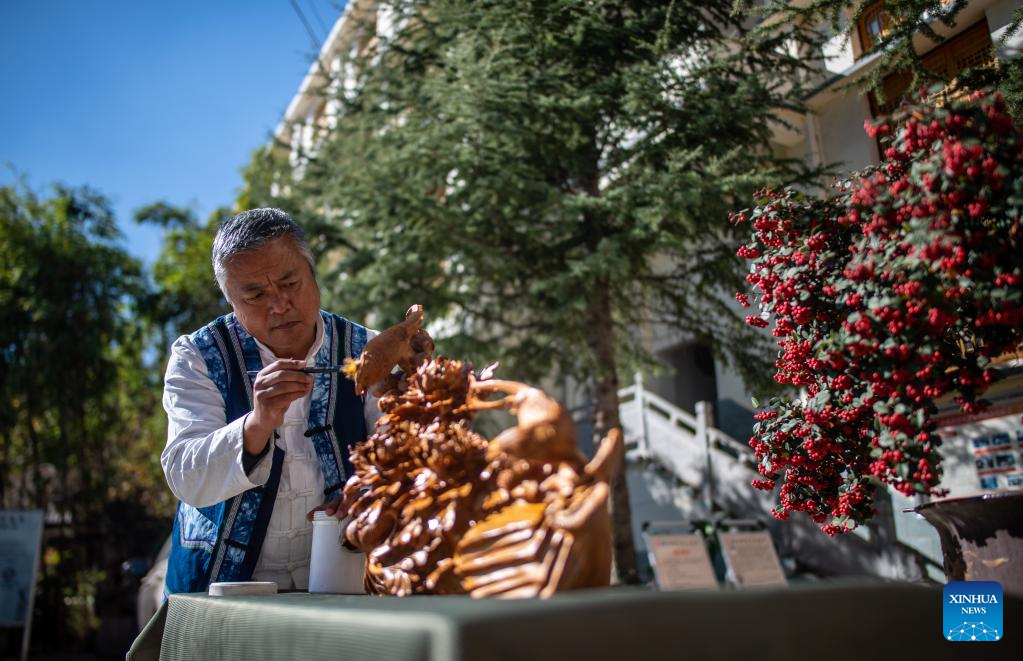
Duan Sixing waxes on his woodcarving work in Jianchuan County, Dali Bai Autonomous Prefecture of southwest China's Yunnan Province, Dec. 2, 2022. Jianchuan County, located in Dali Bai Autonomous Prefecture of southwest China's Yunnan Province, has a long history in woodcarving dating back to the Tang (618-907) and Song (960-1279) dynasties. The carving skills gradually developed from one-layer relief to even seven-layer hollowing relief, and are now applied to making architecture parts, wooden furniture, wall paintings and tourism souvenirs. A high-standard "Four Screens", a representative displaying form of the craft, requires high-level carving skills and costs several months to create. In 2011, Jianchuan woodcarving was listed as one of China's national-level intangible cultural heritages.
Duan Sixing, born in a woodcarving family in Jianchuan County, was deeply edified since childhood by his father and grandfather who were all excellent carpenters. After graduating from middle school, Duan was enrolled into a vocational school to learn woodcarving systematically. "For a new hand, to get in touch with the core skills needs at least three years of sound study, " Duan said. In 2011, Duan took his woodcarving work to participate in an exhibition of Chinese woodcarving at the National Museum of China. In 2014, he brought his Jianchuan woodcarving work to take part in a promotion event of Yunnan Province at the Palace of Nations in Geneva of Switzerland.
Duan was acknowledged as the national-level intangible cultural heritage inheritor of Jianchuan woodcarving in 2018. In an aim to promote the art, he has set up a Jianchuan woodcarving institute at his hometown, and also cooperated with art colleges, encouraging his apprentices to make new creations on the basis of the tradition. "We plan to integrate woodcarving into people's daily life by making creative artworks, so that more people can appreciate Jianchuan woodcarving craft, " said Duan, who is confident in the future of the craft. So far, there are more than 20,000 people engaged in the profession in Jianchuan. (Xinhua/Jiang Wenyao)



